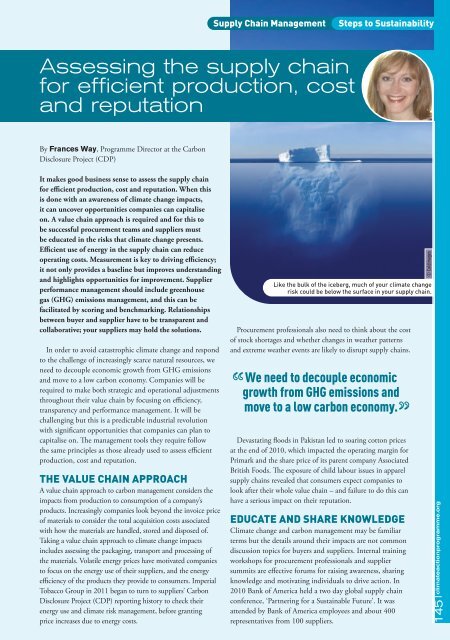Climate Action 2011-2012
You also want an ePaper? Increase the reach of your titles
YUMPU automatically turns print PDFs into web optimized ePapers that Google loves.
supply chain Management<br />
steps to sustainability<br />
Assessing the supply chain<br />
for efficient production, cost<br />
and reputation<br />
By Frances Way, Programme Director at the Carbon<br />
Disclosure Project (CDP)<br />
It makes good business sense to assess the supply chain<br />
for efficient production, cost and reputation. When this<br />
is done with an awareness of climate change impacts,<br />
it can uncover opportunities companies can capitalise<br />
on. A value chain approach is required and for this to<br />
be successful procurement teams and suppliers must<br />
be educated in the risks that climate change presents.<br />
Efficient use of energy in the supply chain can reduce<br />
operating costs. Measurement is key to driving efficiency;<br />
it not only provides a baseline but improves understanding<br />
and highlights opportunities for improvement. Supplier<br />
performance management should include greenhouse<br />
gas (GHG) emissions management, and this can be<br />
facilitated by scoring and benchmarking. Relationships<br />
between buyer and supplier have to be transparent and<br />
collaborative; your suppliers may hold the solutions.<br />
In order to avoid catastrophic climate change and respond<br />
to the challenge of increasingly scarce natural resources, we<br />
need to decouple economic growth from GHG emissions<br />
and move to a low carbon economy. Companies will be<br />
required to make both strategic and operational adjustments<br />
throughout their value chain by focusing on efficiency,<br />
transparency and performance management. It will be<br />
challenging but this is a predictable industrial revolution<br />
with significant opportunities that companies can plan to<br />
capitalise on. The management tools they require follow<br />
the same principles as those already used to assess efficient<br />
production, cost and reputation.<br />
The value chain approach<br />
A value chain approach to carbon management considers the<br />
impacts from production to consumption of a company’s<br />
products. Increasingly companies look beyond the invoice price<br />
of materials to consider the total acquisition costs associated<br />
with how the materials are handled, stored and disposed of.<br />
Taking a value chain approach to climate change impacts<br />
includes assessing the packaging, transport and processing of<br />
the materials. Volatile energy prices have motivated companies<br />
to focus on the energy use of their suppliers, and the energy<br />
efficiency of the products they provide to consumers. Imperial<br />
Tobacco Group in <strong>2011</strong> began to turn to suppliers’ Carbon<br />
Disclosure Project (CDP) reporting history to check their<br />
energy use and climate risk management, before granting<br />
price increases due to energy costs.<br />
Like the bulk of the iceberg, much of your climate change<br />
risk could be below the surface in your supply chain.<br />
Procurement professionals also need to think about the cost<br />
of stock shortages and whether changes in weather patterns<br />
and extreme weather events are likely to disrupt supply chains.<br />
We need to decouple economic<br />
growth from GHG emissions and<br />
move to a low carbon economy.<br />
Devastating floods in Pakistan led to soaring cotton prices<br />
at the end of 2010, which impacted the operating margin for<br />
Primark and the share price of its parent company Associated<br />
British Foods. The exposure of child labour issues in apparel<br />
supply chains revealed that consumers expect companies to<br />
look after their whole value chain – and failure to do this can<br />
have a serious impact on their reputation.<br />
educaTe and share knowledge<br />
<strong>Climate</strong> change and carbon management may be familiar<br />
terms but the details around their impacts are not common<br />
discussion topics for buyers and suppliers. Internal training<br />
workshops for procurement professionals and supplier<br />
summits are effective forums for raising awareness, sharing<br />
knowledge and motivating individuals to drive action. In<br />
2010 Bank of America held a two day global supply chain<br />
conference, ‘Partnering for a Sustainable Future’. It was<br />
attended by Bank of America employees and about 400<br />
representatives from 100 suppliers.<br />
© Coldimages<br />
145 climateactionprogramme.org












